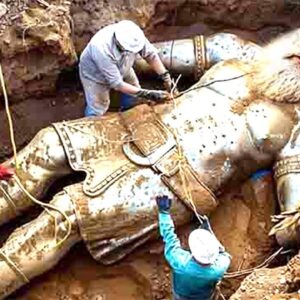In a groundbreaking discovery that will change our understanding of human evolution, archaeologists have uncovered the skeleton of a giant early man with striking features suggesting advanced bipedalism and a unique posture. This find offers new insights into the development of early human ancestors and their adaptations to the environment.




The skeleton, unearthed at a remote excavation site, is notably larger than any known prehistoric human remains. The size and structure of the bones suggest that this individual was significantly taller and more robust than modern humans. The excavation team, led by Dr Helen Carter, found the remains in a good state of preservation, allowing for detailed analysis of the skeletal features.








The discovery of this giant early man’s skeleton challenges existing theories of human evolution. Traditional models of bipedalism emphasize gradual adaptation over time, with early hominins developing upright walking in a relatively linear progression. The advanced bipedalism and unique posture of this giant specimen suggest that early human evolution may have been more complex and varied than previously believed.




Analysis and findings
Initial analysis of the skeleton reveals several unique features:




Leg proportions: The femur and tibia are proportionally longer, which could imply adaptations for long-distance travel or specific locomotion strategies.




These features provide crucial clues about the lifestyle and physical capabilities of this giant early man. The unique posture and bipedal adaptations may have implications for understanding how early humans interacted with their environment and the evolutionary pressures they faced.




The discovery is important not only for its implications for human evolution, but also for its potential to shed light on the diversity of early human species. The existence of such a particular form of bipedalism suggests that early hominins may have exhibited a wider range of physical adaptations than previously recognized.
This find also contributes to the ongoing debate about the factors driving human evolution, such as climate change, environmental pressures and social behaviors. The unique features of the skeleton of this giant early man may offer new insights into these evolutionary forces.
Future research




Conclusion
The discovery of the skeleton of a giant early man with advanced bipedality and a unique posture represents a major milestone in archaeology and evolutionary science. This remarkable discovery challenges existing theories and opens new avenues for research into the adaptations and evolution of early humans. As scientists continue to study these ancient remains, the knowledge gained will contribute to a deeper understanding of our evolutionary history and the diversity of our ancient ancestors.





